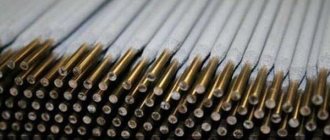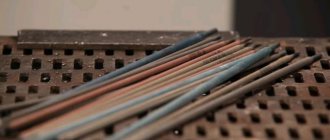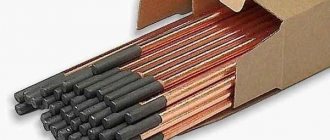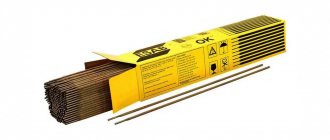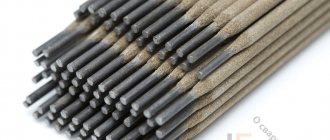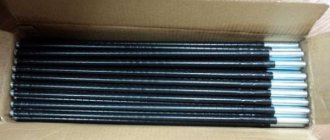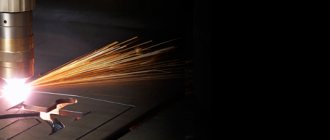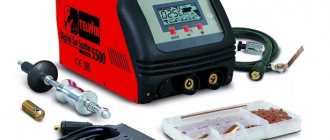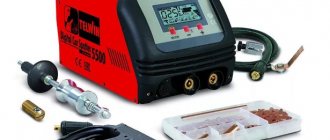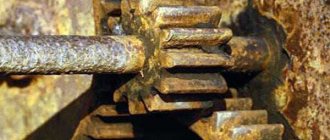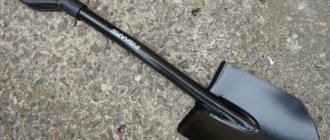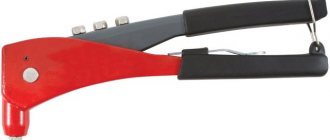Manual arc cutting using electrodes is one of the most popular metal cutting methods. This method is used by both experienced welders and novice welders.
The popularity of this method is due to its relative simplicity: all you need is a welding machine (usually an inverter) and correctly selected electrodes for cutting metal. In this article we will tell you everything about the selection and operation of electrodes used for cutting.
Types of electrodes for cutting
Metal electrodes
Conventional coated metal electrodes are often used for cutting. This can be rutile or basic coating. Overall, the coating results in a smoother cut. The arc burns more stable and does not go out for a long time, the metal practically does not oxidize. But we do not recommend using such electrodes on an ongoing basis, since they are not originally intended for cutting. They can be used to cut cracks or remove seams with defects. We also recommend calcining the electrodes in an oven before starting work.
Carbon electrodes
Cutting metal with a carbon electrode is practically no different from cutting with metal materials. But they are still more intended for cutting. They have one significant advantage: instead of rapidly melting, like metal electrodes, they melt slowly. Because of this, the cut is more accurate.
Another advantage of carbon materials is that they can heat up quite quickly at low current. At the same time, they do not melt up to a temperature of 3000 degrees, so they are consumed quite economically.
Carbon electrode cutting is used for manual arc and oxygen-arc cutting. We recommend setting to straight polarity and constant current. You can set it to variable, but constant is better suited for these purposes.
Tubular electrodes
Tubular electrodes are used in oxygen-arc cutting. They differ from other types of electrodes in that the base is not wire, but a special tube filled with oxygen. The cutting process is similar to the others, but when the metal melts, oxygen begins to be released from the tube. It oxidizes the metal and blows it out, thereby creating a cut. This is an interesting cutting method, but it requires a lot of experience because the arc burns unstable due to the large amount of oxygen produced.
Tungsten non-consumable electrodes
Tungsten electrodes for plasma cutting are used in a protective gas environment. To cut metal, set the amperage to a higher value, more than you use when welding. This way the metal will melt evenly throughout its thickness. In general, tungsten electrodes can be used for work, but they are a very niche material. It will never be universal in your garage.
Price for welding materials
Fill out the form and receive the price list by email.
Until recently, for cutting metals, in practice, only general-purpose welding electrodes were used, which do not provide the required quality of the cut surface and productivity. For cutting, special electrodes are required, which must produce an arc of consistently high thermal power, i.e., allow the use of high current and voltage on the arc. The coating must have high heat resistance and allow the liquid metal to oxidize for easy removal from the cutting site. The listed requirements are met by electrodes of the OZR-1 brand (TU 14-4-321-73) , intended for cutting, gouging, and piercing holes in products made of steel (including corrosion-resistant), cast iron, and copper alloys. The use of electrodes is also advisable for removing defective seams or sections thereof, removing tacks, rivets, bolts, cutting defects, cracks, etc. The purpose of electrodes of the ANR-2 (TU 14-4-682-76) and ANR-2M brands .
Separation and surface cutting (gouging) is carried out in all spatial positions on both direct and alternating current in the following modes depending on the diameter of the electrode: 3 mm - 110-170 A, 4 mm - 180-300 A, 5 mm - 250 -360 A, 6 mm - 350-600 A. The arc voltage when cutting with electrodes of the OZR-1 brand reaches 50-52 V, which exceeds the values obtained both for welding electrodes and for electrodes of the ANR-2 and ANR-2M brands .
Electrodes of the OZR-1 brand have a simple bicomponent coating that does not contain hygienically unfavorable, scarce or expensive components: it consists of hematite and quartz. The oxygen-containing component in the coating of ANR-2 electrodes is manganese ore, which serves as the basis (70%) of the coating. In ANR-2M electrodes, instead of manganese ore, like in OZR-1 electrodes , hematite (60%) is present. When melting electrodes ANR-2, ANR-2M and OZR-1, the total dust emission per kilogram of burned electrodes is 15.9, respectively; 17.2 and 6.1 g, and the content of toxic manganese in it is 10.8; 1.2 and 0%. From a sanitary and hygienic point of view, the use of OZR-1 electrodes is preferable .
The use of special electrodes ensures productivity higher than with mechanical methods of removing defective metal (cutting, grinding), and also provides a significant improvement in working conditions for workers. The cutting speed of cast iron and steel castings is 1.5–2.0 times higher than with carbon electrodes in the same modes during air-arc cutting.
Pros and cons of cutting with electrodes
Any method of cutting metal has its advantages and disadvantages, so cutting with electrodes was no exception. What are the main advantages of this cutting method? Firstly, you do not need to have special equipment or high qualifications to carry out cutting. It is also a relatively safe cutting method, but you still need to follow fire safety regulations.
Among the disadvantages, we note that the cutting speed will directly depend not on your skills and abilities, but on the thickness of the metal. So be patient when cutting thick parts. Also, the quality of the cut leaves much to be desired. The cut is sloppy and uneven. Therefore, this method is not suitable for cutting parts used in the design of swing gates, for example.
Large selection of welding electrodes in Novokuznetsk 8-950-587-78-68 8-909-511-21-45
A clean cut surface is ensured by the presence of oxides in the coating, which prevent particles of molten metal from sticking to it. It is important that when using special electrodes for cutting and gouging that do not contain carbon-containing components in the coating, there is no carburization of the cut edges. This allows you to avoid additional mechanical preparation before subsequent welding.
The use of such electrodes for gouging is of independent interest. The shape of the edges obtained during gouging is close to the requirements of the standards, the cut groove is clean in depth and width, the quality of metal gouging in all spatial positions is good and allows for high-quality formation of the weld without preliminary mechanical cleaning. Gouging productivity up to 50 m/h.
Features of cutting with electrodes
Like any other type of welding work, cutting metal with electrodes has its own characteristics. To make cutting, you must first prepare the device and the metal. Be sure to check the serviceability of your welder and all cables, and do not neglect safety precautions. To ignite the arc, tap the end of the electrode on the metal surface. Experienced welders also use the striking method. Then select the desired operating mode: adjust the current parameter based on the diameter of the electrode and the thickness of the metal. If the metal is thin, then use a 3 mm electrode and increase the diameter as the thickness of the metal increases. When cutting thin metal, you can increase the current setting without fear of ruining the work.
Principle of operation
In order to cut metal using an inverter, you must select the correct current values. This depends on the type of cut, the thickness of the metal and the selected electrode. When separating cutting, the metal sheet should be placed in such a position that the molten metal can flow out freely.
The electrodes must be in a strictly perpendicular position with respect to the surface. If the sheet is located vertically, then the movement of the electrode should be from top to bottom. The electrodes themselves must be thicker than the product being cut. Thin metal can be cut using electrodes with a diameter of 3 millimeters. For thicker ones, electrodes of 4 and 5 millimeters are used.
To eliminate surface defects, surface cutting should be used. In this case, the electrode should be held at a slight angle, five to ten degrees. If it is necessary to make a groove, the electrode must be rocked from one side to the other, gradually immersing it into the cavity being formed.
Electrodes can also be used to cut holes in metal. Melt holes until the desired diameter is achieved. First, burn a small hole, and then gradually expand it. The electrode must be held strictly perpendicular to the surface in which the hole is being cut, otherwise the edges may not be completely smooth. Only minor deviations from a right angle are allowed. Before starting the process, it is necessary to check the serviceability of the equipment used. The arc should be ignited by striking or tapping.
Briefly about inverters
Today there are quite a large number of inverter welding machines.
Most manufacturers offer industrial and household inverters in various price categories. Industrial inverters are distinguished by greater power and increased duty cycle. Also one of the main differences is the maximum output welding current. As a rule, professional devices have higher maximum current values. Another difference may be the ability to connect not only to a 220 V household network, but also to a 380 Volt industrial network. Inverter welders are the most common type of welding machine on the mass market. Due to their versatility and relative compactness, they have practically replaced devices such as transformers and rectifiers. The ability of the inverter to produce direct and alternating current makes it truly universal. This is why all types of coated welding electrodes are suitable for inverter welding. And coupled with its small dimensions and high mobility, this type of equipment remains unrivaled.
